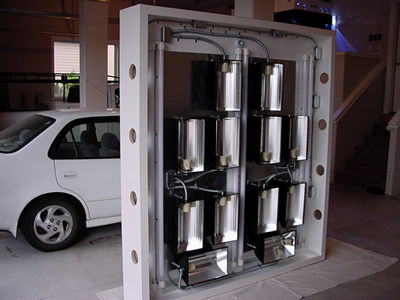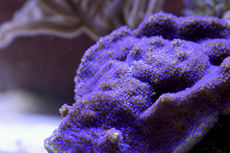|
Featured Member 850 Gallon Dream by steveweast First of all, I would like to thank the Reefland community for bestowing this honor upon my system. To be mentioned in the same breath as the past recipients is truly humbling. I hope that you all enjoy the journey through my system as much as I have enjoyed the journey through the past systems.  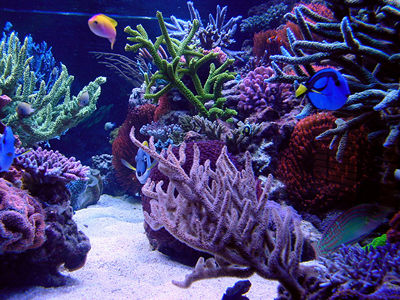 |
|
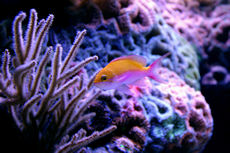 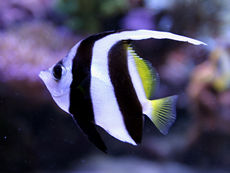 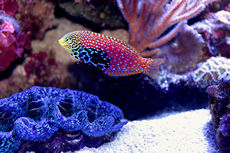 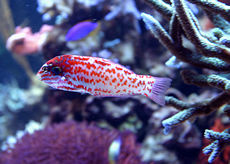 |
(1) Purple Tang – Zebrasoma xanthurum (4) Percula Clowns – Amphipirion percula (10) Green Chromis – Chromis viridis (2) Black Saddle Clowns – Amphipirion polymnus (10) Margarite Damsels – Dascyllus marginatus (1) Golden Angel – Centropyge aurantia (1) Choati Wrasse – Macropharyngodon choati (1) Peppermint Hog – Bodianus sp. (1) Christmas Wrasse – Halichoeres biocellatus (1) Leopard Wrasse – Maccropharyngodon bipartitus (1) Rabbitfish – Siganus virgatus (1) Flame Boxfish – Anaplocapros Lenticularis (5) Schooling Bannerfish – Heniochus diphreutes (6) Skunk Cleaner Shrimp – Lysmata amboinensis (20) Turbo Snails – Turbo fluctuosus (2) Serpent Starfish – Ophioderma squamosissimum |
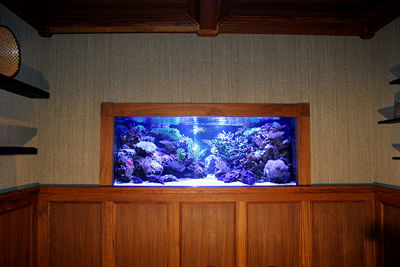 My current water parameters are:Temperature: 78 degrees F +/- 1.0 My current water parameters are:Temperature: 78 degrees F +/- 1.0
Salinity: 1.026 or 35ppt pH: low 8.05 high 8.3 ——————————————————————————– No3: undetectable No2: undetectable NH4: undetectable Po4: undetectable ——————————————————————————– Ca: 420ppm Alk: 9 – 10 DKH Mg: 1300ppm ——————————————————————————– Redox: 380 – 420 (12) 400 watt MH bulbs (10K ushio, MH 14K Aqua Connect, MH 20K Radium) (12) Reef Optix reflectors (6) 165 watt VHO actinic on Ice Cap ballasts (3) dual HQI Sunlight Supply ballasts (3) dual Pulse Start Sunlight Supply ballasts (12) 4â€? cooling fans
|
|
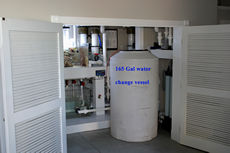 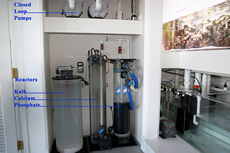 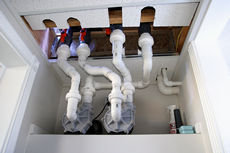 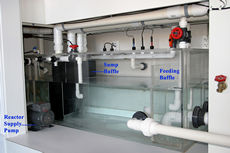 |
Sump:150 galsPumps:(4) Sequence23 6000 pumps for the closed loop(5) Sequence 20 4300 pumps for sump returns, skimmer, and reactors
Calcium reactor: Deltec PF1000 Skimmer: (1) Deltec AP1004 with self cleaning capabilities Kalk reactor: Deltec KM 800 with CaO media Phosphate reactor: Deltec FR 1020 with Rowaphos media UV Sterilizers: (1) Aqua 200 watt single bulb UV sterilizer Refugium: 125 gallons with (4) 30watt T5 10K bulbs Heaters: (2) Aquadyne 1000 watt fire plugs Chillers: (2) Aqualogic 1 3/4hp RO-DI unit: SpectraPure 4 stage unit that produces 100 gal/day Dosing pump: SpectraPure Litermeter 3 Controller: Neptune Aquacontroller Pro |
 Cleaning the front panel is very easy. I use a Magnavore 10 cleaning magnet to accomplish the task. I place a 4 X 6 inch piece of acrylic down onto the sand against the front panel and then place the wet part of the magnet onto the 4 X 6 piece of acrylic. I then go to the viewing side of the front panel and engage the dry part of the magnet to the wet part of the magnet. This method keeps any sand particles from getting trapped between the two parts of the magnet. I just reverse the process to remove the magnets. Cleaning the skimmer: I take apart and clean the skimmer about once a month. Since the drain cup is directly plumbed to the house’s sewer system, there is no urgency as to when I have to clean the skimmer. There is a cup flushing mechanism on the skimmer that flushes the cup daily as well as a brush that automatically cleans the skimmer’s riser tube every 6 hours. Water changes: I replace 165 gals every month or so. I have a 165 gal container that takes about two days for my RO-DI unit to fill. I pour one 200gal bucket of Oceanic salt into the container and let a mag24 pump circulate the water for 24 hours before use. When it comes time to perform the water change, I then turn off my sump pumps ( I leave the closed loop pumps operating) and completely drain the sump plus about half of my refugium: which equals about 165 gallons. I then completely sponge down the empty sump. Finally, I pump the new water back into the sump using the same mag24. The whole process takes about 20 minutes to perform. 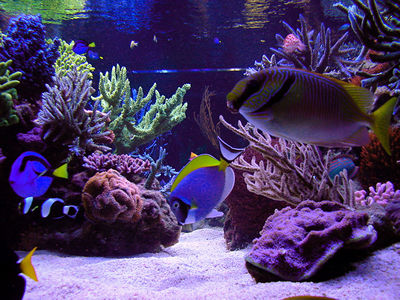 The bonded pre-filter pads are replaced about twice a month. Additives: There are no additives that are used other than 1 liter of carbon changed bi-weekly. Bulb replacement: The metal halide bulbs are replaced every 9 -12 months with the VHO bulbs being replaced every 6 months. Refugium: Since the refugium is bare bottomed, it is easy to vacuum any settled detritus from this area. I vacuum the refugium about twice a month and harvest the Chaetomorpha macro algae about once a month. Feeding: Feeding is performed every other day and consists of various frozen mysis, plankton, squid, scallop and Cyclops-eeze. Nori is also occasionally added. Humidity control: Humidity is removed by an attic exhaust fan that is mounted in the garage. It completely changes the entire garage’s air volume every twenty minutes.  This system was born from the desire to create an aquarium with an extreme front to back dimension. I felt that this huge depth dimension would allow for more natural aquascapng possibilities. From this desire, I decided to break down my existing 500 gal system and replace it with the current 850 gal system. The move had to be done within a 48 hr period to minimize the loss from the 500 gal system. |
|
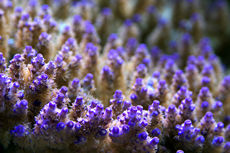 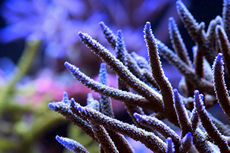 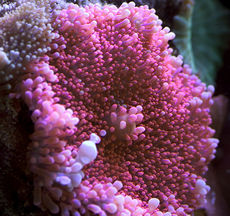 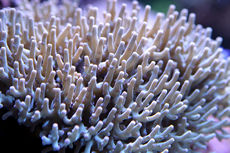
|
With the livestock removed, I disassembled the old tank and light hood. 11am: I began the reframing of the existing stand to accommodate the new tank. Since the new walls were previously framed, dry-walled, and painted, the new floor was the only new construction required on that day. 3pm: With the expanded stand now completed, the new tank was fork-lifted into place along with the new light hood. 5pm: The most time consuming task of switch day was now started: the connection of the new plumbing to the old plumbing. Midnight: The plumbing was sill not finished: go to bed. Day two: It’s now starting to resemble a Trading Spaces episode. 6am: Finish the plumbing. 11am: Begin to fill the new tank with the pre-made water and check for leaks. 2pm: Start returning all the live rock and livestock to the new tank. 9pm: With all the livestock in the new tank and all systems working, it was now time to clean up. This was a huge undertaking that I do not regret. The increased depth component added aquascaping possibilities unheard of on most systems. There has been tweaking here and there; but, most of the replacement labor was accomplished in that very long weekend. |
Favorite coral & fish?I would have to say that my favorite fish is my chaoti wrasse that is seldom seen in captivity. He has lots of personality and great colors. My favorite coral is undoubtedly my Oregon blue tort colony that I’ve grown from a one inch frag.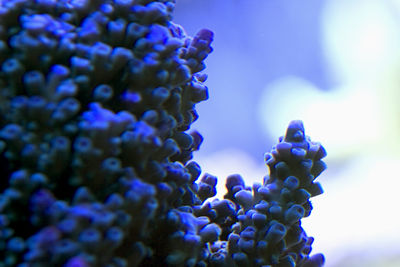 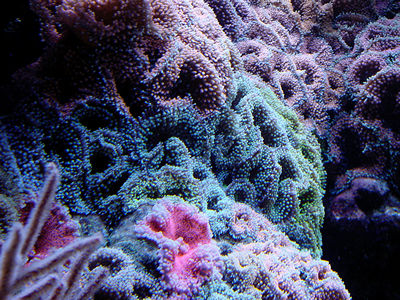 I can really only offer one piece of advice and that is planning. Every system is unique, however, all systems face the same problems. It is how each system and its scale solves these problems that take the thought and planning and can often be the difference from a successful system and a failed system. For example, what is a solution to a humidity problem for my system might not be a workable solution for your system however, a solution must be found for your humidity problem to ensure success. The aquarist must identify and integrate solutions to common problems into his unique design and it this integration that makes each system unique. There is no detailed recipe that will guarantee success. For more information on how I integrated solutions to these common hurdles, please visit my website at www.oregonreef.com. I hope you have enjoyed this brief look at my system as much as I have presenting it. Thank you. If you would like to discuss this feature with Steve or to Congratulate him, please do so in this thread. |
|
Featured Member – 850 Gallon Dream
July 20, 2012 By


